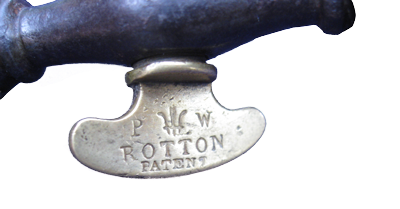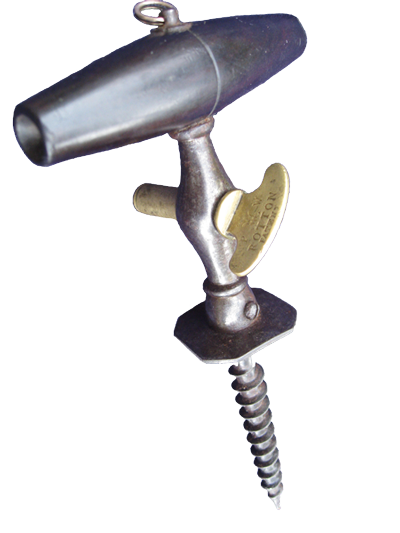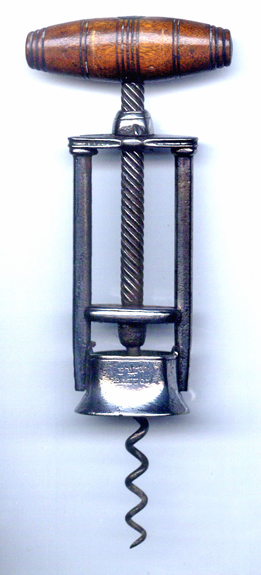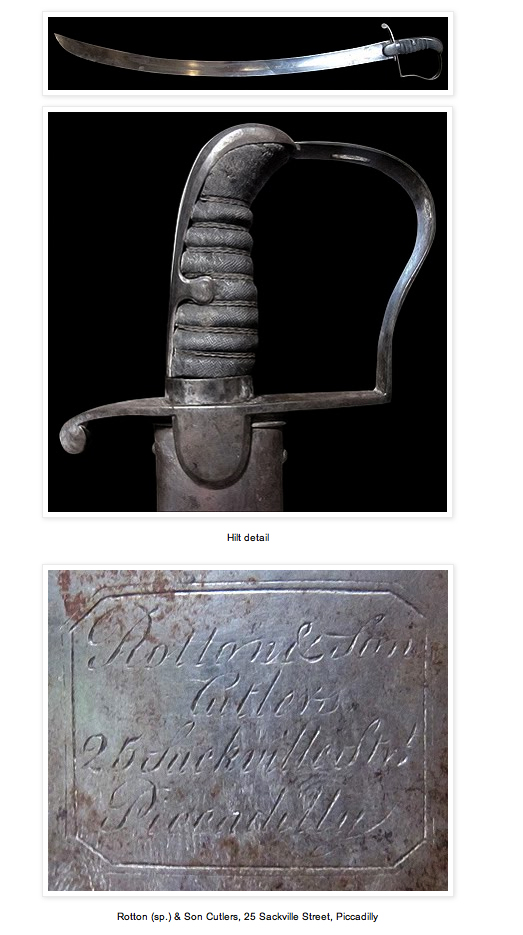John Rotton London Cutler and Corkscrew Maker.
By Steven Webb and Brian May
Corkscrew/Champagne Tap.
The champagne corkscrew below has already been discussed in an earlier article “Rotton Corkscrew” on this website www.corkscrewappraisals.com/. It is a corkscrew with a square Henshall button that also serves as a tap for champagne etc.
The side handle of the tap is marked with three upright ostrich feathers flanked by the initials PW, in the fashion of the Crest of the Prince of Wales. Beneath this, is marked ROTTON PATENT.
The champagne corkscrew is 6" in length, the dark hardwood handle is 3" wide and has no hole for a brush. The hanging ring is faceted and is made from gold rather than the usual steel or brass. One of the more interesting features of this corkscrew is the shape of the button, which is square with its corners cut off, we very rarely see corkscrews with square or multi sided buttons, invariably they are circular in shape.
Patina, simplicity of design and plainess of the handle all point to this being an early champagne corkscrew. This piece is different from general champagne taps, in that a button is fitted above the worm. This enables the piece to be used as an "easer" type corkscrew as well as a champagne tap.


OPERATION.
When used as a champagne tap the entire piece is screwed through the cork and left in place. Due to there being two holes near the bottom of the worm and the worm being hollow, liquid can pass from the bottle when held up side down, to the brass tap in the centre of the shaft. The user can then turn the tap allowing liquid to flow freely. Opening and closing the tap controls the flow of liquid.
When used as a corkscrew, the piece is screwed into the cork as with a normal henshall type corkscrew, the button makes contact with the top of the cork and turns the cork easing extraction.
Two-pillar open-frame corkscrew
Similar markings are also seen on the neck ring of a stunning two-pillar open-frame steel corkscrew (see page 176 of Corkscrews of the Eighteenth Century by Bert Giulian). The initials PW flank the Crest for the Prince of Wales and ROTTON is stamped beneath this. Photographs of this corkscrew have been generously provided by Bert Giulian and are shown below.


.
OPERATION
The Rotton II pillar open framed corkscrew is inserted into the cork by turning the entire corkscrew. An unusual feature is that one of the circular pillars of the frame is hollow and contains a long rod that has two hook extensions, one on top of the frame and one at the bottom, just above the neck ring. In preparation for insertion into the cork, the handle is lowered by turning anti clockwise. As the gliding crossbar reaches the neck ring at the bottom, the hook is engaged, and acting through the rod, the second hook extension at the top elevates and prevents further rotation of the handle.
The handle is then locked and stabilised for insertion of the worm into the cork. To remove the cork, the handle is turned clockwise and the cork is pulled into the frame.
The corkscrew is relatively large with a wide neck ring, larger than can be used on todays magnum sized bottles.
As described by Fletcher Wallis in THE HELIX: an eMagazine for the Corkscrew Collecting Community, Edition 1 July 2011, the London cutler John Rotton manufactured the two-pillar corkscrew. It follows therefore that JOHN ROTTON also manufactured the corkscrew/champagne tap.
Trade card and an invoice
Below is a trade card for John Rotton dated 1803, stating he is cutler to his Royal Highness the Prince of Wales No. 25 Sackville Street Piccadilly. The Prince of Wales, the heir apparent, was later King George IV.
.jpg)
Royal Warrant appointments have been made for centuries and are granted to traders who have a contract to supply goods to members of the Royal Family (in this case the Prince of Wales). This of course lends much prestige to the supplier.
The warrant enabled Rotton to display on his products, the crest of the Prince of Wales, that is, three feathers and as well to use the phrase on his stationery “by appointment to… “ -but Rotton simply said on his trade card “cutler to his Royal Highness…”. Surprisingly, he has mis-spelt Sackville Street on his trade card.
Here is an invoice/ receipt dated February 21/ 25, 1812 for one pound six shillings for an item- possibly a replacement fitting for a sabre/saber carving knife made by Rotton.
.jpg)
Products made by John Rotton
The following notice was inserted by Rotton in The Morning Post on 13 May 1803. Could the occasion in the previous winter be the awarding of his Royal warrant?
.jpg)
This wonderful advertisement appeared in The Morning Post on Tuesday December 25, 1804.
.jpg)
So Rotton at his Wholesale and Retail Cutlery Manufactory at 25 Sackville Street sold fine cutlery, penknives, scissars [sic.], razors, and fine table knives; “new improved corkscrews by which the cork may be extracted whole let it be ever so decayed, with the greatest facility”; improved guard razors; razor straps; improved patent snuffers which extinguish the snuff and can never drop out; improved sabre carving knives; and an assortment of skates. Perhaps the corkscrew here is the two-pillar open framed described earlier.
The following notice from Rotton in The Morning Post on 29 April 1807 makes reference to “Improved Patent Corkscrews”
.
.jpg)
What do we know of John Rotton?
John Rotton was born in Birmingham in January 1761, the son of Ambrose Rotton, a cutler, surgical instrument maker and publican in Birmingham. It is likely John performed his cutler’s apprenticeship in Birmingham. In 1784, he was certainly in London because he married Elisabeth Pavey at St. Marylebone, Westminster. They had seven children including three sons, notably Edward Thomas born in 1797. Wife Elizabeth died at Hayes, Middlesex in 1821 and John at age about 60 years remarried in 1822 to Mary Cecelia Easton.
A John Rotton in March 1797 registered his silver hallmark in London but whether this is our John Rotton is not clear.
John Rotton was shown on a Fire Insurance Record as a cutler at 3 Burleigh Street London in 1799. The business of John Rotton was definitely located at 25 Sackville Street, Piccadilly in 1801 (from a Fire Insurance Record) and he probably was there by 1800.
As shown on the trade card, by 1803 John Rotton was appointed cutler to his Royal Highness the Prince of Wales. A search of London newspapers established that the first mention of, “John Rotton, cutler to his Royal Highness…at 25 Sackville Street” was in a notice inserted by Rotton on 13 May 1803 in The Morning Post (and shown above). The last such notice was inserted by Rotton on 18 May 1817 in The Morning Post.
Hence on this basis, Rotton was a holder of a Royal warrant from about 1803 until 1817.
Partnership with son
John Rotton formed a partnership around 1819 with son Edward Thomas, also a cutler, with the business name of John Rotton & Son at 25 Sackville Street.
Below is a British light calvary sword manufactured by Rotton & Son probably between 1819 and 1821, and at a time when John Rotton was apparently no longer cutler to his Royal Highness. The sword is marked Rotton & Son, cutlers, 25 Sackville Strt., Piccadilly.

The partnership of John Rotton and son Edward Thomas was dissolved on 10 November 1823 and John retired with the business continuing under Edward Thomas.
.jpg)
However, Edward Thomas died soon after in July 1824. The business continued at 25 Sackville Street until 1832 but we do not know who was running the business at this time.
John Rotton died in February 1833 at his property in Hayes, Middlesex at age about 72.
Final comments
Based on our research here, the Rotton corkscrew/champagne tap and two-pillar open- frame corkscrew were made by John Rotton early in the 19th century perhaps sometime between 1803 and 1817.
Such two-pillar open frame corkscrews are known from the late 18th century (see Chapter 9 of Corkscrews of the Eighteenth Century by Bert Giulian).
However, the Rotton corkscrew/champagne tap could the earliest of its type and could pre-date the earliest documented English champagne tap- a rare silver-mounted tap made in 1807 in London by Phipps and Robinson.
Rotton marked his corkscrew/champagne tap with the word PATENT no doubt to discourage any competitors but he did not bother to take up a patent. In fact, the first patent for a champagne tap was not taken out until 1828 in France.
As a final point it is worth noting that Rotton would not have been the only cutler supplying the Prince of Wales with products. The Prince most likely purchased special products from certain cutlers. For example, the leading royal sword cutler, Samuel Brunn at 56 Charing Cross, at the time of Rotton, was “sword cutler” to The Prince of Wales. Perhaps the Prince of Wales purchased corkscrews from Rotton and these were put to good use at royal functions.
Sources: British Museum online information, National Archives UK, Britishnewspaperarchive.co.uk, The London Knife book by Ron Flook.
Acknowledgements: Thanks to Bert Giulian for kindly supplying photographs. Thanks also to Samantha John, a descendant of John Rotton, for her assistance with family tree details; Samantha was located on www. Genesreunited.co.uk.

